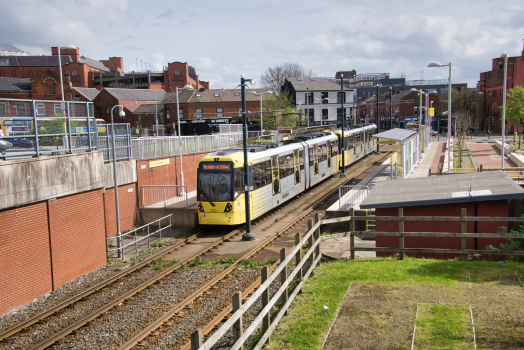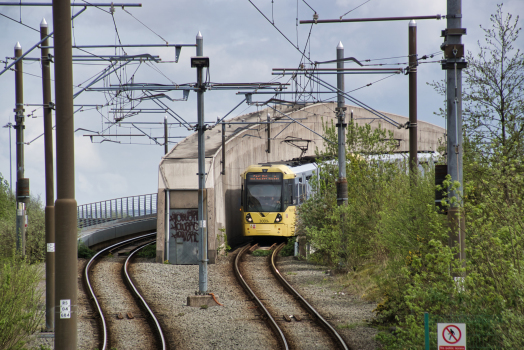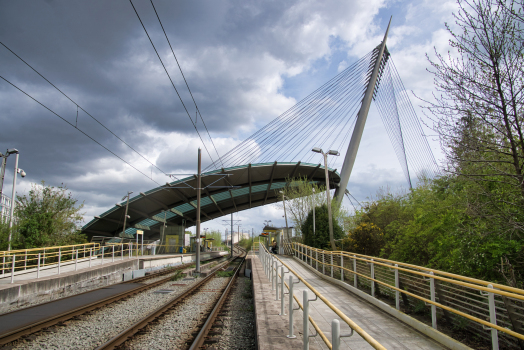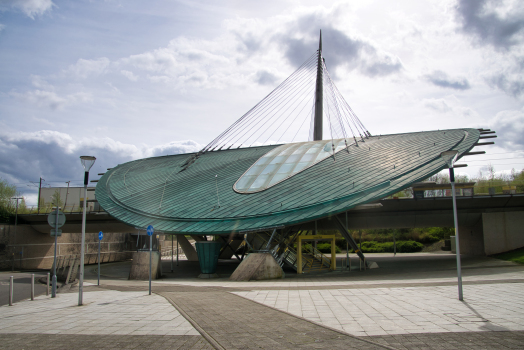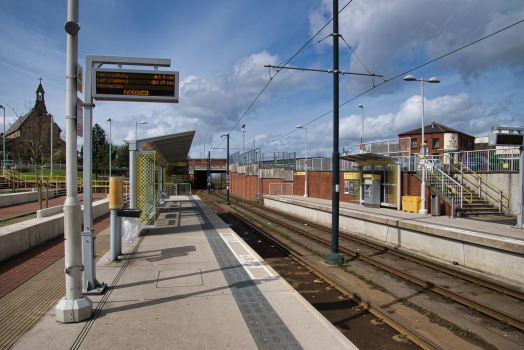General Information
| Completion: | 6 April 1992 |
|---|---|
| Status: | in use |
Project Type
| Function / usage: |
Light rail transit network |
|---|
Location
| km | Name |
Technical Information
Dimensions
| number of stations | 99 | |
| system length | 103 km | |
| maximum speed | 80 km/h | |
| track gauge | 1 435 mm |
Excerpt from Wikipedia
Manchester Metrolink is a tram/light rail system in Greater Manchester, England. The network has 99 stops along 64 miles (103 km) of standard-gauge route, making it the most extensive light rail system in the United Kingdom. Over the 2022/23 financial year 36 million passenger journeys were made on the system.
Metrolink is owned by the public body Transport for Greater Manchester (TfGM) and is part of the region's Bee Network. It is operated and maintained under contract by a Keolis/Amey consortium.
The network consists of eight lines which radiate from Manchester city centre to termini at Altrincham, Ashton-under-Lyne, Bury, East Didsbury, Eccles, Manchester Airport, Rochdale and The Trafford Centre. It runs on a mixture of on-street track shared with other traffic; reserved track sections segregated from other traffic, and converted former railway lines.
Metrolink is operated by a fleet of 147 high-floor Bombardier M5000 light rail vehicles. Each service runs to a 12-minute headway; stops with more than one service experience combined headways of 6 minutes or less. At the busiest times some services operate as 'doubles', with two vehicles coupled together.
A light rail system for Greater Manchester emerged from the failure of the 1970s Picc-Vic tunnel scheme to obtain central government funding. A light-rail scheme was proposed in 1982 as the least expensive rail-based transport solution for Manchester city centre and the surrounding Greater Manchester metropolitan area. Government approval was granted in 1988, and the network began operating services between Bury Interchange and Victoria on 6 April 1992. Metrolink became the United Kingdom's first modern street-running rail system; the 1885-built Blackpool tramway being the only first-generation tram system in the UK that had survived up to Metrolink's creation.
Expansion of Metrolink has been a critical strategy of transport planners in Greater Manchester, who have overseen its development in successive projects, known as Phases 1, 2, 3a, 3b, 2CC and Trafford Park. The latest extension, the Trafford Park Line from Pomona to the Trafford Centre, opened in March 2020. The Greater Manchester Combined Authority has proposed numerous further expansions of the network, including the addition of tram-train technology to extend Metrolink services onto local heavy-rail lines.
History
Predecessors
Manchester's first tram age began in 1877 with the first horse-drawn trams of Manchester Suburban Tramways Company. Electric traction was introduced in 1901, and the municipal Manchester Corporation Tramways expanded across the city. By 1930, Manchester's tram network had grown to 163 route miles (262 km), making it the third-largest tram system in the United Kingdom. After World War II, electric trolleybuses and motor buses began to be favoured by local authorities as a cheaper transport alternative, and by 1949 the last Manchester tram line was closed. Trolleybuses were withdrawn from service in 1966.
Origins
Greater Manchester's railway network historically suffered from poor north–south connections because Manchester's main railway stations, Piccadilly and Victoria, were built in the 1840s on peripheral locations outside Manchester city centre. The central commercial district had no rail links, and over the years, several unsuccessful schemes were proposed to connect Manchester's rail termini. In the 1960s, transport design studies were undertaken to address the problems of increasing traffic congestion. Many urban public transport schemes were evaluated for Manchester, including several types of monorail systems and metro-style systems.
While the monorail schemes were all abandoned, a scheme to create a tunnel link gained momentum. The SELNEC Passenger Transport Executive — the body formed in 1969 to improve public transport for Manchester and its surrounding municipalities – promoted the 'Picc-Vic tunnel' project. The project was a proposal to link Piccadilly and Victoria stations via a tunnel under the city centre and enable train services to run across the Manchester conurbation. Greater Manchester County Council (GMC) inherited the project and presented it to the United Kingdom Government in 1974, but the council failed to secure the necessary funding, and the project was abandoned in 1977. The Centreline shuttle bus service provided inter-station links for many years.
The Greater Manchester Passenger Transport Executive (GMPTE), the successor to SELNEC, continued to examine possible rail link solutions. Light rail emerged in the early 1980s as a cost-effective option that could make use of existing railway lines and run through the city centre at street level, eliminating the need for costly tunnelling works. A Rail Study Group, composed of officials from British Rail, GMC and GMPTE formally endorsed the Project Light Rail scheme in 1984. Initial abstract proposals, based on light rail systems in North America and continental Europe, illustrated a draft 62-mile (100 km) network consisting of three lines: Altrincham–Hadfield/Glossop, Bury–Marple/Rose Hill and Rochdale–East Didsbury. To promote the scheme, GMPTE held a public proof of concept demonstration in March 1987 using a Docklands Light Railway P86 train on a freight-only line adjacent to Debdale Park. The Project Light Rail proposals were presented to the UK Government for taxpayer funding; following route revisions in 1984 and 1987, Project Light Rail was approved. Because of the central government's constraints on financial support for innovative transport projects, funding was granted by HM Treasury with the strict condition that the system be constructed in phases. Additional taxpayer funding came from the European Regional Development Fund and bank lending.
Construction
Parliamentary authority to proceed with Phase 1 construction was obtained with two Acts of Parliament – the Greater Manchester (Light Rapid Transit System) Act 1988 and Greater Manchester (Light Rapid Transit System) (No. 2) Act 1988.
Phase 1: Bury, Altrincham and Manchester city centre
Beginning in July 1991, the first Phase of Metrolink involved the conversion of two suburban heavy rail lines to light rail operation — the Bury-Victoria line in the north and the Altrincham-Piccadilly line in the south — and the construction of a street-level tramway through the city centre to connect the two. Tracks were laid down along a 1.9-mile (3.1 km) route from Victoria station, via Market Street to the G-Mex, with a 0.4-mile (0.64 km) branch to Piccadilly station. This route is now known as the First City Crossing (1CC), and it was built with network expansion in mind.
A fleet of 26 AnsaldoBreda T-68 light rail vehicles was procured to operate the 19.2-mile (30.9 km) network. Construction was carried out by the GMA Group (a consortium of AMEC, GM Buses, John Mowlem & Company and GEC), costing £145 million (equivalent to £319 million in 2021).
Metrolink was initially scheduled to open in September 1991, but services did not begin until 1992, when the Bury Line opened as far as Victoria on 6 April. The first street-level trams began running on 27 April between Victoria and G-Mex (now Deansgate-Castlefield), the Altrincham line opened on 15 June, and the branch to Piccadilly station opened on 20 July. Metrolink was officially opened by Queen Elizabeth II on 17 July 1992.
Phase 2: Salford Quays, Eccles
In Phase 2 the Metrolink network was extended westwards to Eccles along the new 4-mile (6.4 km) Eccles Line, as part of the 1990s urban regeneration of Salford Quays, increasing the total Metrolink route length to 24 miles (39 km). The extension cost £160 million (equivalent to £287 million in 2021) and was funded by the GMPTA, the ERDF and private developers. It was constructed 1997–99 by Altram (a consortium of Serco, Ansaldo and John Laing) and six new AnsaldoBreda T-68 A trams were bought to operate services. The line was inaugurated by Prime Minister Tony Blair on 6 December 1999 but temporarily terminated at Broadway as the street running section was completed. The complete line was officially opened by Princess Anne on 9 January 2001.
Phase 3
The Phase 3 extension project, nicknamed the "Big Bang", was promoted by GMPTE and the Association of Greater Manchester Authorities (AGMA) in the early 2000s. The project, costing £489,000,000 (equivalent to £876 million in 2021), would create four new lines: the Oldham and Rochdale Line, the East Manchester Line, the South Manchester Line and the Airport Line. Phase 3 was put in doubt when central government funding was withdrawn due to increasing costs, but after negotiations with the Department for Transport, Phase 3 was split into two parts, 3a and 3b, to secure investment. Phase 3b was delayed after a failed bid to raise funding through the Greater Manchester Transport Innovation Fund and a proposed traffic congestion charge in 2008. GMPTE and AGMA instead funded Phase 3b through a combination of council tax, government grants, Metrolink fares and contributions from the Manchester Airports Group and other bodies. The new 0.25-mile (0.40 km) spur off the Eccles Line to MediaCityUK was funded separately by the Northwest Regional Development Agency. As part of Phase 3, the original blue T-68 trams were also phased out and replaced with a new fleet of Bombardier M5000 trams, which entered service in December 2009.
Phase 3a: Oldham, Rochdale, South and East Manchester
Beginning in October 2009, Phase 3a involved converting the 14-mile (23 km) Oldham Loop heavy rail line to light rail operation and adding several new tram stops on the route; re-opening a disused 1.7-mile (2.7 km) section of Cheshire Lines Committee railway to use as the first part of the South Manchester Line (to St Werburgh's Road); and building a new 4-mile (6.4 km) East Manchester Line as far as Droylsden. When completed in 2013, Phase 3a increased Metrolink's total network length to 43 miles (69 km).
Phase 3b: Ashton-under-Lyne, East Didsbury and Manchester Airport
Phase 3b involved the construction of a new 9-mile (14 km) Airport Line to Manchester Airport, and extending three of the new Phase 3a lines: the East Manchester Line to Ashton-under-Lyne; the South Manchester Line to East Didsbury; and adding street-running routes through Oldham and Rochdale town centres to the Oldham and Rochdale Line. Construction work began in March 2011, and Phase 3b was completed in November 2014 with the opening of the Airport line.
Phase 2CC – Second City Crossing
With increased tram traffic brought about by the expansion of the Metrolink network, it became necessary to build a new route across Manchester City Centre to alleviate congestion and improve capacity.
Known as the Second City Crossing (or 2CC), the project involved laying 0.8 miles (1.3 km) of tram tracks from St Peter's Square tram stop via Princess Street, Albert Square, Cross Street and Corporation Street to rejoin the original Metrolink line just before Victoria station. One new tram stop was built at Exchange Square. The project also involved re-ordering St Peter's Square and re-siting the Cenotaph to accommodate an enlarged tram interchange and junction. Construction began in 2014, and the 2CC route opened fully in February 2017.
Trafford Park extension
The Transport & Works Act Order for the 3.4 mile (5.4 km) Trafford Park Line was granted in October 2016. Enabling works began in January 2017. The line opened on 22 March 2020.
Rolling stock
Current fleet
Because low-floor tram technology was in its infancy when Metrolink was in its planning stages, and in order to be compatible with the former British Rail stations that Metrolink inherited, the network uses high-floor trams with a platform height of 900 mm (35 in), the same height as main line trains.
Trams on Metrolink operate either single units, or coupled together to form double units, which regularly run during peak hours.
Bombardier M5000
In December 2009, Metrolink took delivery of the first Bombardier M5000 tram. Built by Bombardier Transportation and Vossloh Kiepe, the initial eight M5000s were ordered to allow services to be increased. They are part of the Bombardier Flexity Swift range of light rail vehicles and have a design similar to the K5000 vehicle used on the Cologne Stadtbahn.
With the approval of the spur to MediaCityUK, a further four were ordered. To provide rolling stock for the phase 3 extensions and replace the existing fleet, the order was increased successively to 94. In December 2013, a further 10 M5000s were ordered to provide trams for the Trafford Park Line planned to open in 2020, while in the interim supporting a service between MediaCityUK and Manchester city centre and other capacity enhancements. In September 2014, a further 16 were ordered; the final one of which was delivered in October 2016, bringing the fleet up to 120.
In July 2018, a further 27 were ordered to help relieve overcrowding. Delivered from November 2020, the final tram was delivered in October 2022.
Ancillary vehicles
Metrolink has several ancillary vehicles used for maintenance within depots. The "Special Purpose Vehicle", later numbered 1027 with its support wagon 1028, is a bespoke diesel-powered vehicle dating from the networks construction in 1991. It is fitted with a crane, inspection platform, mobile workshop, and capacity for a driver and three passengers. It was designed to assist with vehicle recovery and track and line repairs although to the end of its service life rarely left its base at Queens Road Depot. By January 2023 both 1027 & 1028 had been withdrawn from service for disposal.
In 2020 Metrolink took delivery of a Zephir Crab 2100E, a small battery powered vehicle for use moving trams within the depot. It is based at Queens Road to replace the Special Purpose Vehicle. Trafford depot operates a smaller Zephir Crab 1500E dating from construction of the depot in 2011. A Unimog road-rail vehicle was added to the fleet in mid-2022 to support infrastructure inspection and maintenance activities.
Infrastructure
Lines
As of August 2022, Metrolink has a network length of 64 miles (103 km) and 99 stops — along eight lines which radiate from a "central triangular junction at Piccadilly Gardens which forms the hub of the Metrolink system" in Zone 1.
The lines are: the Airport Line (which terminates at Manchester Airport), the Altrincham Line (which terminates in Altrincham), the Bury Line (which terminates in Bury), the East Manchester Line (which terminates in Ashton-under-Lyne), the Eccles Line (which terminates in Eccles), the Oldham and Rochdale Line (which terminates in Rochdale), the South Manchester Line (which terminates in East Didsbury), and the Trafford Park Line (which terminates at the Trafford Centre).
Tram stops
There are 99 tram stops on Metrolink, as of 2023. Low-floor platforms commonly used for light rail throughout the world were ruled out for Metrolink because the system inherited 90-centimetre (35 in) high-floor platforms from British Rail on lines formerly used for heavy rail. The first stops on the Bury Line and Altrincham Line, opened in phase one, were formerly railway stations and were changed little from British Rail days, as available funding only allowed minimum upgrades to be made. When the Oldham and Rochdale Line was converted from a railway, however, all of the former railway stations were completely rebuilt.
Some stops, such as Cornbrook, are shared between lines, and may be used as interchange stations; others, such as Altrincham Interchange, or Ashton-under-Lyne are transport hubs that integrate with heavy rail and bus stations.
Metrolink stops are unstaffed. Each contains at least two ticket vending machines (except for Pomona, which only has one). Card readers are installed on all stop platforms for use with contactless pay-as-you-go, the TfGM 'My Get Me There' smart card, and concessionary passes. All card users are required to touch-in at these platform readers before commencing their journey and to touch-out at their final destination. Stops are provided with help/emergency call points to enable passengers to speak to control. Each stop is monitored by CCTV for public safety, and the images are continuously recorded. Route maps and general information are provided on each platform. Each stop has at least one high-floor platform measuring a minimum of 2 metres (6.6 ft) wide, accessed by ramp, stairs, escalator, lift or combination thereof. Shelters and canopies at stops were supplied by JCDecaux, and ticket vending machines by Scheidt & Bachmann.
Power supply
The trams are electrically powered from 750 V DC overhead lines. Between 1992 and 2007, electricity for the Metrolink system was procured by the operator, based on price only. In 2007, GMPTE changed the contractual requirements to ensure that sustainable power would be factored into choosing an energy supplier, and in July 2007, Metrolink became the first light rail network in the UK with electricity supplied entirely from sustainable energy via hydropower. Now, energy for the system is generated by biomass.
Depots
Metrolink has two depots, at Queens Road and Old Trafford: Metrolink House at Queens Road in Cheetham Hill was the original headquarters of Metrolink. Constructed during Phase 1 alongside the Bury Line, it served jointly as a control centre, HQ, office space, and depot for the storage, maintenance and repair of vehicles. Under the original proposals, Metrolink House was intended to be much larger, with a design which would support network expansion, but this design did not obtain the necessary planning permission from Manchester City Council. Consequently, Metrolink House was scaled down to a 4-hectare (9.9-acre) £8,000,000 site with limited capacity, and, in light of Phase 3a network expansion, the second depot in Old Trafford was built in 2011. This second depot, adjacent to the Old Trafford tram stop, occupies the site of a former warehouse and can stable up to 96 vehicles, it also has a washing plant and maintenance workshops. On 7 May 2013 Metrolink completed the transfer of its main operational functions from Queens Road to Old Trafford, meaning its control room – known as the Network Management Centre – is housed jointly with the Customer Services team by its newer depot.
Fares and ticketing
Metrolink fares were initially set by the system's operator, but are now set by the TfGM Committee at levels that cover both the running costs and the cost of borrowing that has part-funded the expansion of the system; Metrolink receives no public subsidy. Fares typically rise each January above the rate of inflation. The fare tariff is based on a division of the network's stops into fare zones. Persons under 16 years of age, persons of pensionable age, and people with disabilities qualify for concessionary fares, some of which are mandatory and others discretionary, as determined by the Greater Manchester Combined Authority. The Greater Manchester Combined Authority permits reduced fares for persons under 16 years of age, and free or reduced fares on Metrolink after 9:30 a.m. for pensioners. In normal circumstances, tickets cannot be purchased on board Metrolink vehicles and must be purchased from a ticket vending machine before boarding the vehicle.
Fare evasion in 2006 was estimated at 2–6% of all users, and in 2012 at 2.5% of all users. Checking tickets and passes and issuing Standard fares (similar to penalty fare) is the responsibility of Metrolink's Passenger Services Representatives (PSRs), who provide security and assistance on the network; between 1992 and 2008, Greater Manchester Police had a dedicated Metrolink unit responsible for policing the system.
Thorn EMI designed the original ticket vending machines. In 2005 GMPTE announced that rail passengers travelling from within Greater Manchester into Manchester city centre could use the Metrolink service between the then eight City Zone stops for free. Passengers must present a valid rail ticket, correctly dated with Manchester Ctlz as the destination. In 2007 TfGM rolled out new ticket vending machines, designed to accept credit/debit card payments and permit the purchase of multiple tickets in a single transaction. These were replaced in 2009 with touchscreen machines, designed with the Scheidt & Bachmann Ticket XPress system.
In October 2012, TfGM announced it was devising a more straightforward zonal fare system, comparable to London fare zones, and preparing to introduce get me there, the region's new contactless smartcard system, for use on all public transport modes in Greater Manchester, including Metrolink. After years of consultation, a new system using four concentric zones was implemented on 13 January 2019. From 15 July 2019, a new contactless pay-as-you-go service began, allowing passengers to tap in and out on smart readers using their contactless bank cards. Contactless fares were originally capped to no more than the cost of the equivalent daily travelcard. In September 2021 an additional weekly cap was introduced.
Text imported from Wikipedia article "Manchester Metrolink" and modified on April 18, 2024 according to the CC-BY-SA 4.0 International license.
Participants
Currently there is no information available about persons or companies having participated in this project.
Relevant Web Sites
Relevant Publications
- (2007): Design and construction of the Metrolink Finback Bridge. In: Proceedings of the Institution of Civil Engineers - Bridge Engineering, v. 160, n. 2 (June 2007), pp. 71-79.
- (1994): Manchester Metrolink - diversion of public utilities' apparatus. In: Proceedings of the Institution of Civil Engineers - Transport, v. 105, n. 2 (May 1994), pp. 111-118.
- (2001): Metrolink—building on success. In: Proceedings of the Institution of Civil Engineers - Transport, v. 147, n. 3 (August 2001), pp. 201-208.
- (1992): Planning and financing Manchester Metrolink. In: Proceedings of the Institution of Civil Engineers - Transport, v. 95, n. 3 (January 1992), pp. 141-150.
- (2014): Refurbishment of structures on the Manchester Metrolink phase 3. In: Proceedings of the Institution of Civil Engineers - Bridge Engineering, v. 167, n. 3 (September 2014), pp. 202-218.
- About this
data sheet - Structure-ID
20088255 - Published on:
11/04/2024 - Last updated on:
25/11/2024

